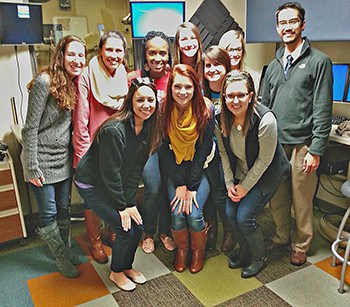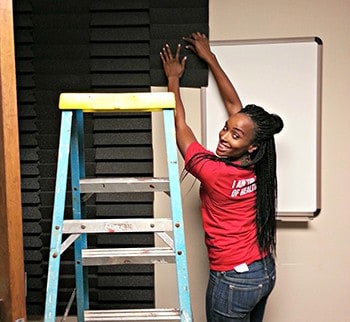Audiology Students Soundproof the UAMS Sim Center
| 
A group of audiology students led a soundproofing project for the control room of the UAMS Simulation Center.

Audiology student Rose Dockery places a foam panel on the wall in the Sim Center’s control room to reduce the amount of noise.
Dec. 17, 2013 | While the UAMS Simulation Center gives students and health care professionals experience practicing skills in a realistic environment with high-tech manikins, faculty members and the center’s staff had noticed a problem.
During a simulation, faculty members observe the learners from a control room through a one-way glass panel. Simulation Center staff members also are in the control room to run the computerized, full-bodied human simulators and ensure a quality education experience.
When the center would conduct two procedures simultaneously in separate simulation theaters, the faculty and Simulation Center staff for the two
simulations overheard each other as well as the
voices of the learners in both theaters, said
Michael Anders, Ph.D., director of the Simulation Center. Sounds reverberated off the control room’s hard floor and walls.
“It became difficult for the faculty to focus on the performance of the learners in the simulation theater they were observing,” Anders said. “The noise made it challenging to conduct and assess concurrent simulations.”
Anders said his daughter, Megan Cates, a graduate of the UAMS audiology doctoral program in the College of Health Professions, suggested sound proofing the control room might be a good service learning project for audiology students. Anders and Samuel Atcherson, Ph.D., an associate professor in the audiology program, agreed.
A team of Atcherson’s students took sound measurements in the control room. The students then assisted with the installation of square foam panels on the walls and carpet tiles over the hard floor, both intended to absorb sound energy and reduce sound reflections. Another sound measurement was taken after the work was complete.
The measurements calculated both how long it took sound to be absorbed and how much background noise was present.
“We were able to put our learning into action by recording noise levels and reverberation before and after the modifications,” said audiology student Stacey Williams. “I also got to help place carpet tiles on the floor to dampen the noise levels. When we were finished, I could hear the difference with my own ears, as well as see it in our measurements.”
Anders called the project a success. “The sound level is both quantitatively and qualitatively lower. We are very pleased,” he said. Faculty members who recently used the control room to monitor simulation education activities have been enthusiastic about the improvements.
The three-year old Simulation Center is busy — hosting a projected 700 simulation education events in 2013, he said, adding that he expected the number to increase. “The soundproofing of the control room is a good example of our effort to provide outstanding services to UAMS colleges, students, UAMS Medical Center and other health professionals,” Anders said.
For the students, Atcherson said the project offered a practical exercise in the sound level measurement skills they had been learning.
“As future audiologists, some of these students may well be involved in the schools where classrooms are often noisy and reverberant, while others may be involved in hearing conservation programs to help employees prevent noise-related hearing loss and this reinforces their training in addressing those situations,” Atcherson said. “Lastly, this was a collaborative, service-learning project requiring on-the-fly problem solving with a real benefactor — and it was one where the students excelled.”